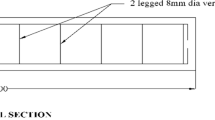Abstract
Of many fast growing grasses around the world, bamboo has been persistently investigated as a possible reinforcing element in concrete. In addition to the existing knowledge on the subject, this study has performed an experimental and numerical analysis of flexural behaviour of large-scale bamboo-reinforced concrete beams containing crushed sand. The crushed sand was used as complete replacement of natural river sand at 0 and 100%, while bamboo was substituted for steel reinforcement bars at 50 and 100%. Other concrete ingredients cement, granite, and mixing water were kept constant. Curing of hardened beams was by immersion in water for 28, 56, and 84 days’ regimes. Finite element/numerical modelling and analysis of beams was performed using ABAQUS software. A nonlinear model analysis with static loading was considered with a predefined 3D model. The concrete fracture pattern was smeared crack, in the mode I. The results showed that a partial (50%) or total (100%) replacement of steel with bamboo and total replacement of natural river sand with crushed sand gave somewhat similar performance in flexure as the control beams. As expected, steel-reinforced beams were better in terms of strength across all curing regimes; however, members reinforced with 50% bamboo, although with about 14% lesser strength but having minimal deformation and crack propagation, can also be a sustainable alternative for construction. Overall, the results somewhat validate the obtained experimental flexural strength of the beams.















Similar content being viewed by others
References
Vogtländer J, van der Lugt P, Brezet H (2010) The sustainability of bamboo products for local and Western European applications: LCAs and land-use. J Clean Prod 18:1260–1269. https://doi.org/10.1016/j.jclepro.2010.04.015
Ikponmwosa E, Fapohunda C, Kolajo O, Eyo O (2015) Structural behaviour of bamboo-reinforced foamed concrete slab containing polyvinyl wastes (PW) as partial replacement of fine aggregate. J King Saud Univ Eng Sci. https://doi.org/10.1016/j.jksues.2015.06.005
Lima HC, Willrich FL, Barbosa NP, Rosa MA, Cunha BS (2008) Durability analysis of bamboo as concrete reinforcement. Mater Struct 41:981–989. https://doi.org/10.1617/s11527-007-9299-9
Ghavami K (2008) Bamboo: low cost and energy saving construction materials. In: Xiao Y, Inoue M, Paudel S (eds) Modern bamboo structures. London, UK, pp 5–21
Dey A, Chetia N (2018) Experimental study of bamboo reinforced concrete beams having various frictional properties. Mater Today Proc 5:436–444. https://doi.org/10.1016/j.matpr.2017.11.103
Karthik S, Rao PRM, Awoyera PO (2017) Strength properties of bamboo and steel reinforced concrete containing manufactured sand and mineral admixtures. J King Saud Univ Eng Sci 29(4):400–406. https://doi.org/10.1016/j.jksues.2016.12.003
Karthik S, Rao RM, Awoyera P, Akinwumi I, Karthikeyan T, Revathi A, Mathivanan J, Manikandan V, Saravanan S (2018) Beneficiated pozzolans as cement replacement in bamboo-reinforced concrete: the intrinsic characteristics. Innov Infrastruct Solut 3:50. https://doi.org/10.1007/s41062-018-0157-0
Awoyera PO, Ede AN (2017) Bamboo versus tubular steel scaffolding in construction: pros and cons. In: Reference module in materials science and materials engineering. Elsevier, Amsterdam
Ede A, Olofinnade O, Awoyera P (2018) Structural form works and safety challenges: role of bamboo scaffold on collapse of reinforced concrete buildings in Nigeria. Int J Civ Eng Technol 9:1675–1681
Moroz JG, Lissel SL, Hagel MD (2014) Performance of bamboo reinforced concrete masonry shear walls. Constr Build Mater 61:125–137. https://doi.org/10.1016/j.conbuildmat.2014.02.006
Laroque P (2007) Design of a low-cost bamboo footbridge. Massachusetts Institute of Technology
Janssen J (2000) Designing and building with bamboo: INBAR Technical Report 20. Beijing, China
Rahman N, Shing LW, Simon L, Philipp M, Alireza J, Ling CS, Wuan LH, Valavan S, Nee SS (2017) Enhanced bamboo composite with protective coating for structural concrete application. Energy Procedia 143:167–172. https://doi.org/10.1016/j.egypro.2017.12.666
Javadian A, Wielopolski M, Smith IFC, Hebel DE (2016) Bond-behavior study of newly developed bamboo-composite reinforcement in concrete. Constr Build Mater 122:110–117. https://doi.org/10.1016/j.conbuildmat.2016.06.084
Ghavami K (2005) Bamboo as reinforcement in structural concrete elements. Cem Concr Compos 27:637–649. https://doi.org/10.1016/j.cemconcomp.2004.06.002
Agarwal A, Nanda B, Maity D (2014) Experimental investigation on chemically treated bamboo reinforced concrete beams and columns. Constr Build Mater 71:610–617. https://doi.org/10.1016/j.conbuildmat.2014.09.011
Awoyera PO, Adesina A (2017) Structural integrity assessment of bamboo for construction purposes. In: Reference module in materials science and materials engineering. Elsevier, Amsterdam
Shen W, Liu Y, Wang Z, Cao L, Wu D, Wang Y, Ji X (2018) Influence of crushed sand’s characteristics on its concrete performance. Constr Build Mater 172:574–583. https://doi.org/10.1016/j.conbuildmat.2018.03.139
Shen W, Liu Y, Cao L, Huo X, Yang Z, Zhou C, He P, Lu Z (2017) Mixing design and microstructure of ultra high strength concrete with crushed sand. Constr Build Mater 143:312–321. https://doi.org/10.1016/j.conbuildmat.2017.03.092
IS 2386 (2002) Method of test for aggregate for concrete. Indian Stand
IS 6874 (2008) Method of test for bamboo
IS 456 (2000) Plain and reinforced concrete-code of practice
IS 13311-1 (1992) Method of Non-destructive testing of concret, part 1: ultrasonic pulse velocity
IS: 516 (1959) Method of tests for strength of concrete
Agarwal A, Nanda B, Maity D (2014) Experimental investigation on chemically treated bamboo reinforced concrete beams and columns. Constr Build Mater 71:610–617. https://doi.org/10.1016/j.conbuildmat.2014.09.011
Awoyera P (2016) Nonlinear finite element analysis of steel fibre-reinforced concrete beam under static loading. J Eng Sci Technol 11:1–9
Acknowledgements
This research was fully supported by the VIT University, Vellore, India.
Author information
Authors and Affiliations
Corresponding author
Ethics declarations
Conflict of interest
None.
Rights and permissions
About this article
Cite this article
Awoyera, P.O., Karthik, S., Rao, P.R.M. et al. Experimental and numerical analysis of large-scale bamboo-reinforced concrete beams containing crushed sand. Innov. Infrastruct. Solut. 4, 41 (2019). https://doi.org/10.1007/s41062-019-0228-x
Received:
Accepted:
Published:
DOI: https://doi.org/10.1007/s41062-019-0228-x




